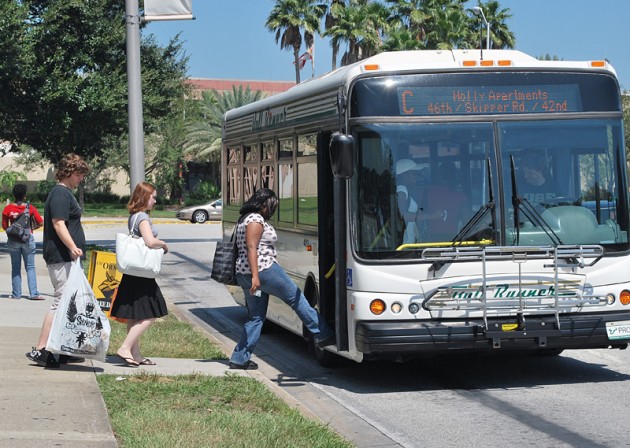Keeping track of the Bull Runner

A new bus-tracking system utilizing GPS technology is being considered that would allow students to better budget their time when waiting for the Bull Runner.
Plans for a bus-tracking system began last spring when Student Body President Gregory Morgan was contacted by a company offering this service. Morgan was serving as Student Government Director of Student Life and Development at the time. He said he feels that such a system would directly benefit students.
The tracking system would give a second-by-second update of the exact location of each Bull Runner and would allow students to access this information on the Internet, said Andrew Cohen, coordinator for the SG Department of Academic and University Affairs. Students would be able to get this information on their computers or portable digital devices.
“You could see exactly where it is. If you were on a computer you would hold your mouse over the bus and see if it is running on time or a little behind time,” he said.
Cohen added that another option being investigated is placing a television in the Marshall Student Center or the Library that would display a map tracking all of the buses.
Both Morgan and Cohen said they feel that waiting for the Bull Runner is a safety concern when students are waiting for an extended period of time, especially at night.
“It’s a safety issue at stops like (those on) Sycamore (Drive), where at night there’s not very good lighting and it’s close to off campus,” said Morgan.
Marcela Oliveira, a junior majoring in physical education, feels safe waiting for the buses. However, she does find waiting for long periods of time a major inconvenience.
“Once I was late to class and I was waiting for a bus,” she said. “When it came, it was full — so it couldn’t even stop for me.”
Parking and Transportation Services Director Manuel Lopez said he feels the tracking system will have benefits for the busing department and the students.
“We maintain approximately 10-minute headways on all routes, so under normal conditions there should not be that long of a wait,” Lopez said. “It will be beneficial in the sense that riders can better plan their time at the stops, and we can better manage the routes.”
Once a company is chosen, the business will send technicians out to train the bus operators and physically install the devices, Cohen said.
Currently, only an estimated cost for this tracking system is available. It is highly probable that USF will go with the company NextBus, Cohen said.
“The initial cost will be around $70,000. Yearly, it would cost $35,000,” he said.
Once a company is chosen, SG may use a portion of the Activity & Service fees students pay as part of their tuition to finance the system. However, SG is also trying to negotiate splitting the cost with the parking and transportation department.
“We will work with Student Government to see if a partnership between Student Government and Parking and Transportation Services can happen,” Lopez said.
Bus-tracking companies already have systems in place at institutions such as the University of Alabama, North Carolina State University and the University of Florida.
“It is the best thing. I’d say — definitely money well spent,” said NCSU Information and Communications Specialist for Transportation Christine Klein. “If anything, it is working too well for us. Students are now able to wait until the last second to get to the bus stop, which causes overcrowded buses.”
The University of Florida launched their bus-tracking system in June. Students find the site an amazing tool that minimizes wait time, said Bob Miller, UF’s associate vice president of business affairs.
If the tracking system is approved, timing is a concern.
“In a perfect world, I’d like to see this in February,” Cohen said. “Realistically, it will probably be summer.”






